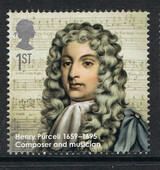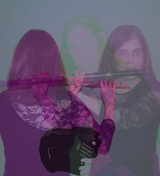
Henry Purcell's Dido and Aeneas has been my next research project. When I first heard the opera, I wasn't at all sure that I would enjoy it, but after all the work analysing it, I'm a real fan.
Henry Purcell was just an infant when Charles II was invited back to England, and in his mid-twenties when James II succeeded to the throne in 1685. He trained as a choir boy at the Chapel Royal, and went on to become a court composer, the organist at Westminster Abbey, and a renowned harpsichord player and teacher before his untimely death at the age of 36.
Dido and Aeneas was Purcell’s first opera and seems to have had little initial impact. After an early amateur performance at Josias Priest’s Board School for girls in 1689 (although it is unclear whether it was performed at Court previously), Dido and Aeneas remained unpublished until 1841.
The opera is in three acts. Act I opens with an Overture based on the French overture form of a slow start followed by a fugal second part. Lovely arias including “Shake the cloud from off your brow”, and “Ah Belinda, I am press’d with torment” are interspersed with choruses and “recitatives” (speech-like solo singing). The first act concludes with an uplifting chorus “To the hills and the vales” followed by an enchanting instrumental dance, “The triumphing dance”.
Behind Purcell’s beautiful music and Nahum Tate’s libretto setting of the Aeneid, lies a world of political uncertainty, constitutional upheaval and social critique. The opera is full of characters who give or receive bad advice, all of it ultimately shown to be ill-considered and misguided.
There is controversy around the dating of the work. Those who date it before the Glorious Revolution of 1688, suggest that Dido and Aeneas is a political allegory, critical of the breakdown of constitutional principles and the subsequent undermining of the divine right of kings. If dated at 1689, Dido and Aeneas can be viewed as a criticism of the new monarchs, Dutch William of Orange, and his wife Mary, the daughter of the deposed James II. It may even be a warning to William to treat Mary well. Either way, Dido’s death is unusual and foreboding in an opera of the period, and coincided with Purcell’s declining popularity in the new Court.
Musically, Dido and Aeneas demonstrates Purcell’s genius. He was skilled at “word painting”, using music to embody meaning, as for example the dissonance when Dido sings “Peace and I are strangers...”. Purcell did not create word painting, it was frequently used in Elizabethan and Baroque music, but he was a master at it. Similarly, he had a gift for English prosody, accurately recreating the rhythms of the English language in his music.
Purcell also showed extraordinary talent in the way he employed musical keys to underlie the drama. Most of the opera is in C minor, which represents pain and suffering. Happier scenes, such as the lovely “Fear no danger” duet and chorus are set in C major, the “royal” key. F major is Purcell’s love key and G minor is his death key, used as foreshadowing in “Ah Belinda” and then towards the end of Act III in “Dido’s Lament”.
Over two hundred years after Purcell composed Dido and Aeneas, a group of music students, including the young Ralph Vaughan Williams and Gustav Holst, were instrumental in reviving the opera for the 1895 bicentennial of Purcell’s death. Today, it is still frequently performed and recorded. Henry Purcell’s Dido and Aeneas may have been ‘just’ a small opera, but it continues to illuminate a watershed in English history and is cherished as early English music.
Henry Purcell was just an infant when Charles II was invited back to England, and in his mid-twenties when James II succeeded to the throne in 1685. He trained as a choir boy at the Chapel Royal, and went on to become a court composer, the organist at Westminster Abbey, and a renowned harpsichord player and teacher before his untimely death at the age of 36.
Dido and Aeneas was Purcell’s first opera and seems to have had little initial impact. After an early amateur performance at Josias Priest’s Board School for girls in 1689 (although it is unclear whether it was performed at Court previously), Dido and Aeneas remained unpublished until 1841.
The opera is in three acts. Act I opens with an Overture based on the French overture form of a slow start followed by a fugal second part. Lovely arias including “Shake the cloud from off your brow”, and “Ah Belinda, I am press’d with torment” are interspersed with choruses and “recitatives” (speech-like solo singing). The first act concludes with an uplifting chorus “To the hills and the vales” followed by an enchanting instrumental dance, “The triumphing dance”.
Behind Purcell’s beautiful music and Nahum Tate’s libretto setting of the Aeneid, lies a world of political uncertainty, constitutional upheaval and social critique. The opera is full of characters who give or receive bad advice, all of it ultimately shown to be ill-considered and misguided.
There is controversy around the dating of the work. Those who date it before the Glorious Revolution of 1688, suggest that Dido and Aeneas is a political allegory, critical of the breakdown of constitutional principles and the subsequent undermining of the divine right of kings. If dated at 1689, Dido and Aeneas can be viewed as a criticism of the new monarchs, Dutch William of Orange, and his wife Mary, the daughter of the deposed James II. It may even be a warning to William to treat Mary well. Either way, Dido’s death is unusual and foreboding in an opera of the period, and coincided with Purcell’s declining popularity in the new Court.
Musically, Dido and Aeneas demonstrates Purcell’s genius. He was skilled at “word painting”, using music to embody meaning, as for example the dissonance when Dido sings “Peace and I are strangers...”. Purcell did not create word painting, it was frequently used in Elizabethan and Baroque music, but he was a master at it. Similarly, he had a gift for English prosody, accurately recreating the rhythms of the English language in his music.
Purcell also showed extraordinary talent in the way he employed musical keys to underlie the drama. Most of the opera is in C minor, which represents pain and suffering. Happier scenes, such as the lovely “Fear no danger” duet and chorus are set in C major, the “royal” key. F major is Purcell’s love key and G minor is his death key, used as foreshadowing in “Ah Belinda” and then towards the end of Act III in “Dido’s Lament”.
Over two hundred years after Purcell composed Dido and Aeneas, a group of music students, including the young Ralph Vaughan Williams and Gustav Holst, were instrumental in reviving the opera for the 1895 bicentennial of Purcell’s death. Today, it is still frequently performed and recorded. Henry Purcell’s Dido and Aeneas may have been ‘just’ a small opera, but it continues to illuminate a watershed in English history and is cherished as early English music.

 RSS Feed
RSS Feed